How to Use Japanese Forest Grass in Landscape Design
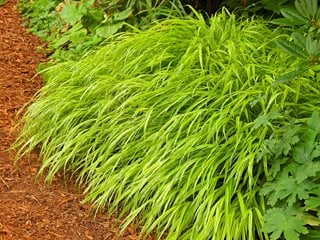
Japanese forest grass. (Hakonechloa macra 'Aureola'). Photo by Janet Loughrey.
Ornamental grasses offer subtle beauty and multi-seasonal interest, even when there's not much else going on in the garden. Grown for their structure, texture, reliability and virtually carefree nature, the uses for ornamental grasses are many. Whether used as a background plant, hedging, erosion control along a slope, or a dazzling accent in a container or water feature, ornamental grasses make an invaluable addition to any landscape.
Many ornamental grasses are invasive in certain areas of the country. However, there are native and non-invasive alternatives for many of them. Also, in areas of high fire danger, grasses should be cut back to just a few inches once they have died back for the year. Otherwise, dried grasses and their seed heads can provide winter interest.
On this page: Tall Ornamental Grasses | Short Ornamental Grasses | Native Grasses
- TALL ORNAMENTAL GRASSES
- SHORT ORNAMENTAL GRASSES
- NATIVE GRASSES
Love the look of ornamental grasses, but not sure how to incorporate them in your garden or landscape? See 5 Uses for Ornamental Grasses, from Proven Winners.
TALL ORNAMENTAL GRASS VARIETIES
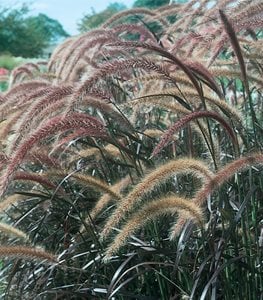
Photo by: Proven Winners.
GRACEFUL GRASSES® PURPLE FOUNTAIN GRASS
Pennisetum setaceum 'Rubrum'
Zones:
9-11
Height/Spread:
Upright arching habit, 2 to 4 feet tall and 2 to 3 feet wide
Exposure:
Full sun to partial shade
Add soft texture and graceful movement to the landscape, with months of color from summer to frost. Deep purple foliage is topped by dusky mauve flower plumes on graceful, arching stems. Grow this virtually carefree grass as hedging, massed along a slope, in a container by itself, or in combination with other plants. Treat as an annual in all but the warmest regions. Unlike some other fountain grasses, this does not reseed.
Learn more about how to grow and care for purple fountain grass.
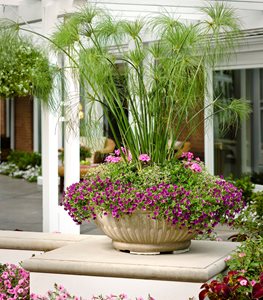
King Tut® center (thriller). Photo by: Proven Winners.
GRACEFUL GRASSES® KING TUT®, Egyptian papyrus
Cyperus papyrus
Zones:
10-11
Height/Spread:
Upright open habit, 4 to 6 feet tall and 3 to 4 feet wide
Exposure:
Full sun to partial shade
This medium-sized aquatic sedge has triangular stems topped with bushy tassels that can reach 6 to 12 inches across. The graceful arching habit and showy flowers make a stunning statement when planted in shallow water at the edge of a pond or water feature. Use in a container as a stand-alone accent, or in combination with other annuals with similar needs. Treat as an annual in all but the warmest regions.
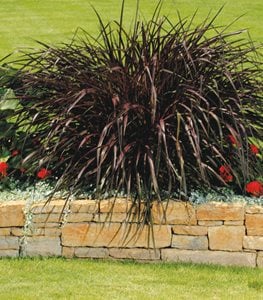
Photo by: Proven Winners.
GRACEFUL GRASSES® VERTIGO®, Elephant Grass
Pennisetum purpureum
Zones:
8-11
Height/Spread:
Upright bushy habit, 3 to 8 feet tall and 2 to 3 feet wide
Exposure:
Full sun
The deep midnight color, strappy foliage, and larger stature lend a commanding presence in the landscape. Use as a stand-alone container specimen, massed in the landscape, or in combination with other plants. The nearly black coloring contrasts dramatically with brighter hues such as gold, orange, or chartreuse. Combine with coleus, Rudbeckia, or sweet potato vine. Treat as an annual in cooler regions.
See more about where this grass may be aggressive.
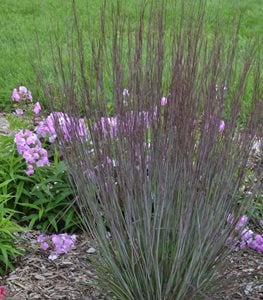
Photo by: Proven Winners.
PRAIRIE WINDS® 'BLUE PARADISE', Little bluestem — Buy now from Proven Winners
Schizachyrium scoparium
Zones:
3-9
Height/Spread:
Upright vase-shaped habit, 3 to 3-1/2 feet tall and 2 feet wide
Exposure:
Full sun
The smokey mauve-blue foliage, vertical stature, and subdued texture lend sophistication to any style landscape. Use as a background element, in a mixed border, massed in a bed or along a slope. This North American prairie native supports insects and wildlife and can be naturalized in a field or open woodland setting. Burgundy-red fall foliage is especially dramatic when backlit by early or late-day sun. Exceptionally hardy in colder zones.
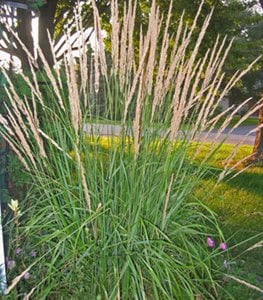
Photo by: Proven Winners.
'KARL FOERSTER', Feather reed grass — Buy now from Proven Winners
Calamagrostis x acutiflora
Zones:
5-9
Height/Spread:
Upright open habit, 3 to 6 feet tall and 2 to 3 feet wide
Exposure:
Full sun to partial shade
Feathery bronze flower spikes create texture and movement in the landscape, providing multi-seasonal interest from early summer through winter. This standard landscape plant is often used in public settings, valued for its toughness and reliability. Plant in a mixed border, or mass in landscape or curbside plantings. Tolerant of heat and heavy clay soil; grows in most regions.
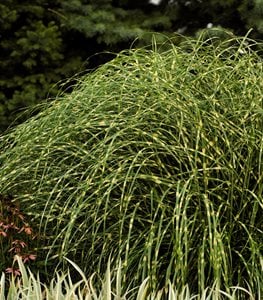
Photo by: Proven Winners.
'LITTLE ZEBRA', Dwarf zebra grass — Buy now from Proven Winners
Miscanthus sinensis
Zones:
5-9
Height/Spread:
Upright arching habit, 3 to 4 feet tall and 2 to 3 feet wide
Exposure:
Full sun to partial shade
Zebra grass is grown for its attractive leaves, which have distinct horizontal bands, as well as the showy copper-pink flower plumes that appear in mid-summer. Long popular with avid gardeners, the green-and-gold striped foliage makes this an outstanding background plant in a mixed border. This dwarf form was developed for smaller spaces, with a shorter stature that stays more upright. Grow in containers, mass plantings, as hedging or a focal point.
See more about where this grass may be problematic.
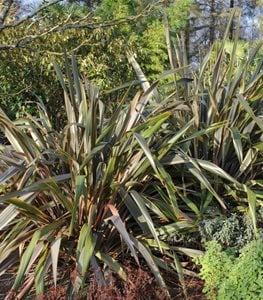
Photo by: Peter Turner Photography / Shutterstock.
NEW ZEALAND FLAX
Phormium tenax, P. cookianum and hybrids
Zones:
8-11
Height/Spread:
Upright or arching habit, 1-1/2 to 12 feet tall and 1-1/2 to 10 feet wide
Exposure:
Full sun to partial shade
New Zealand flax creates high drama in the garden with bold architectural structure and upright spiky foliage. It occurs in a range of colors and sizes, making a versatile design element in any space, from small urban yards to larger landscapes. Use as a focal point in a border or container. Combine with plants with softer texture and flowers for contrast. In cooler regions, this can be grown as an annual.
SHORT ORNAMENTAL GRASS VARIETIES
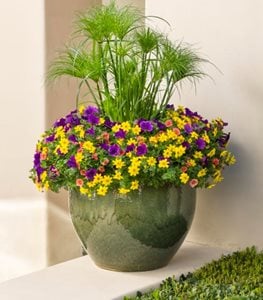
Prince Tut™ center (thriller). Photo by: Proven Winners.
GRACEFUL GRASSES® PRINCE TUT™, Dwarf Egyptian papyrus
Cyperus papyrus
Zones:
10-11
Height/Spread:
Upright open habit, 1-1/2 to 2-1/2 feet tall and 2 to 3 feet wide
Exposure:
Full sun to partial shade
This aquatic African sedge, which is grown as an annual in most regions, is a popular choice for boggy soils, or along the shallow edge of a pond or marsh. The graceful vase-shaped habit and showy flower tufts lend an exotic look, with striking architectural appeal. This dwarf variety, with sturdy stems that won't flop, is a good choice for containers and small water features.
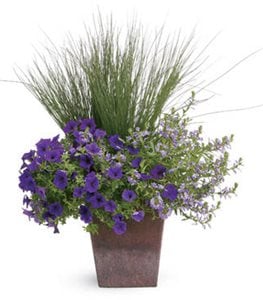
Blue Mohawk®, center. Photo by: Proven Winners.
GRACEFUL GRASSES® BLUE MOHAWK®, Soft rush
Juncus inflexus
Zones:
5-9
Height/Spread:
Upright spiky or arching habit, 2 to 3 feet tall and 1-2 feet wide
Exposure:
Full sun to partial shade
This hardy rush or sedge is grown for its dense upright clusters of reed-like blades and tiny cone-like tan flowers. Tough and versatile, this hardy grass prefers moist soil conditions or shallow water such as found alongside stream beds and marshes. Create year-round structural interest, even in winter with a fresh coat of snow. Plant in a water feature, rain garden, or an area of the yard with boggy soil.
See where this grass may be problematic.
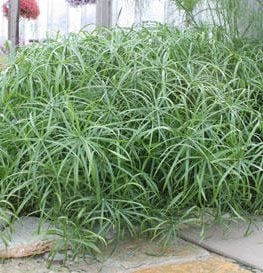
Photo by: Proven Winners.
GRACEFUL GRASSES® BABY TUT, Umbrella grass
Cyperus involucratus
Zones:
9-11
Height/Spread:
Upright open or arching habit, 1-1/2 feet tall and wide
Exposure:
Full sun to partial shade
This aquatic sedge is grown for its exotic appearance, vase-shaped structure and radiating umbrella-like leaf bracts. Also known as dwarf papyrus grass, the diminutive stature makes this a good choice for small spaces. Grow in wet, boggy soils, or shallow water at the edge of a pond or water feature. Use in containers, rain gardens, and miniature ponds. Treat as an annual in cooler regions. In frost-free climates, plants can spread aggressively through self-seeding and root rhizomes.
See where this grass may be problematic.
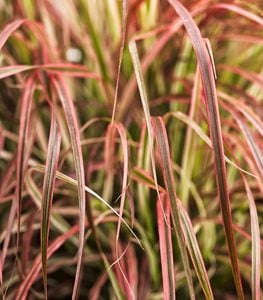
Photo by: Proven Winners.
GRACEFUL GRASSES® 'FIREWORKS', Variegated red fountain grass
Pennisetum setaceum 'Fireworks'
Zones:
9-11
Height/Spread:
Open arching habit, 2 to 3 feet tall and 1-1/2 to 2 feet wide
Exposure:
Full sun
This variation of the more common purple fountain grass is grown for its striking variegated foliage with stripes of purple, burgundy, green and white. Pale burgundy flower tassels appear from mid-summer to frost. This more compact variety is suitable for small urban yards. Mass in the landscape, or plant in a container by itself or in combination with other plants with similar needs. Treat as an annual in most regions. Does not reseed like some other pennisetums.
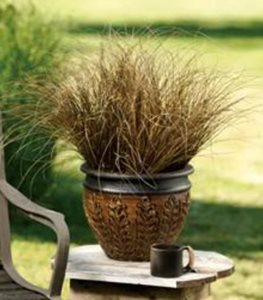
Photo by: Proven Winners.
GRACEFUL GRASSES® TOFFEE TWIST, Toffee Twist sedge
Carex flagellifera
Zones:
7-10
Height/Spread:
Upright bushy or arching habit, 1-1/2 to 2 feet tall and wide
Exposure:
Full sun to partial shade
Grown for its fine-textured foliage and graceful arching structure, this carefree sedge makes an elegant container accent or contrasting design element to flowering annuals and perennials. Plant at the front of a mixed border or mass along a slope for erosion control. The compact size makes this a good choice for small urban spaces, and the rustic brown foliage complements any color scheme or garden style.
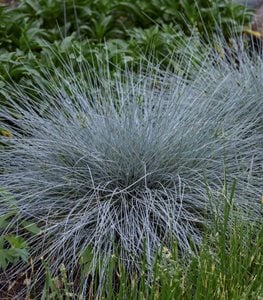
Photo by: Walters Gardens.
'BLUE WHISKERS' Blue fescue — Buy now from Proven Winners
Festuca glauca
Zones:
4-8
Height/Spread:
Clumping habit, 10 to 12 inches tall and 24 to 28 inches wide
Exposure:
Full sun to partial shade
Steel-blue whisker-like foliage and tan seed heads complement most other colors, making this a versatile design choice. This fine-textured grass makes a striking accent in a container or the landscape. With tolerance to drought and poor soils, along with its spreading habit, this makes a good choice for massing in a bed or along a slope for erosion control. Smaller than blue oat grass, the compact size is especially suited to urban lots. Exceptionally hardy in colder regions.

Photo by: Janet Loughrey.
JAPANESE FOREST GRASS, syn. Golden Japanese forest grass, Hakone grass
Hakonechloa macra 'Aureola'
Zones:
5-9
Height/Spread:
Mounding weeping habit, 1 to 1-1/2 feet tall and 2 feet wide
Exposure:
Partial shade, with protection from hot afternoon sun
One of the few ornamental grasses that thrives in partial shade, this golden variety is especially useful for illuminating darker spaces. Leaves are variegated, with thin stripes of gold and green that acquire hints of coppery pink in fall. The elegant cascading form is popular in Japanese-style and other formal landscapes, and takes a dormant rest in late fall. Combine with other woodland shade lovers such as hostas, ferns, azaleas and Japanese maple. Use along the front of a mixed border, in mass plantings or containers.
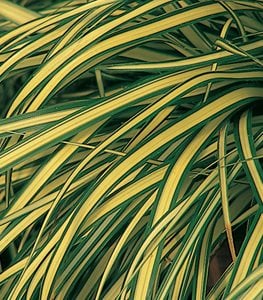
Photo by: Proven Winners.
'EVERGOLD', Japanese Sedge — Buy now from Proven Winners
Carex oshimensis 'Evergold' (syn. C. hachijoensis)
Zones:
5-9
Height/Spread:
Mounding arching habit, 8 to 18 inches tall and 1 to 2 feet wide
Exposure:
Full sun to partial shade
Weeping variegated foliage is eye-catching in a container, rock garden, or mixed border. Strappy fine-textured leaves, which have a gold stripe down the middle and contrasting green margins, stand out in the landscape. The diminutive stature and compact growth habit makes this a good choice for small spaces. Use as a stand-alone accent, as edging, in mass plantings, or container combinations. Somewhat shade tolerant.
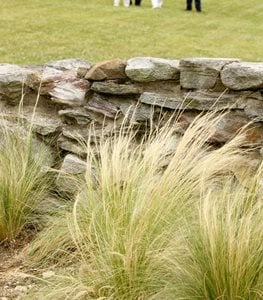
Photo by: Proven Winners.
MEXICAN FEATHER GRASS — Buy now from Proven Winners
Stipa tenuissima (syn. Nassella tenuissima)
Zones:
6-10
Height/Spread:
Upright arching habit, 1 to 3 feet tall and 1 to 2 feet wide
Exposure:
Full sun to partial shade
Grown for its ethereal cloud-like plumes that sway in the slightest breeze, Mexican feather grass is useful for creating dynamic movement and fine texture in the landscape. Combine with bold structural plants such as globe allium for visual contrast. Plant in containers, massed in a bed or along a slope. Drought-tolerance and carefree nature makes this a good choice for xeriscapes and rock gardens. An emerging invasive plant in California, as it can self-sow readily. (Plantright.org offers more information and suggested alternatives for California gardens.)
Alternatives: Bouteloua gracilis 'Blonde Ambition' blue grama grass, alkali sacaton (Sporobolus airoides), Mexican deer grass (Muhlenbergia dubia), purple three-awn (Aristida purpurea), and autumn moor grassSesleria autumnalis)
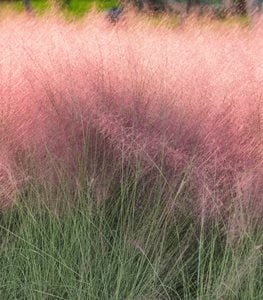
Photo by: atiger / Shutterstock.
PINK MUHLY GRASS
Muhlenbergia capillaris
Zones:
6-9
Height/Spread:
Upright mounding habit, 2 to 3 feet tall and wide
Exposure:
Full sun to partial shade
For high drama in the late-season landscape, few plants rival that of pink muhly grass. From late summer to fall, bright pink seed heads form billowy cotton candy-like drifts, creating soft texture and riveting color, especially when backlit by early or late day sun. Plant in drifts for maximum impact along a slope, or naturalize in a meadow or native garden. The seed heads fade to tan, creating long-lasting winter interest in the garden.
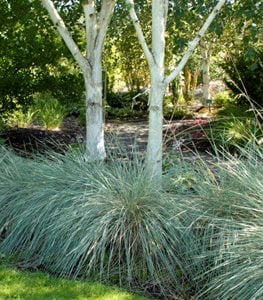
Photo by: Kathryn Roach / Shutterstock.
BLUE OAT GRASS
Helictotrichon sempervirens
Zones:
4-8
Height/Spread:
Mounding arching habit, 2 to 4 feet tall and 2 to 3 feet wide
Exposure:
Full sun to partial shade
Popular in public landscapes and home gardens, this commonly used ornamental grass is grown for its pale blue foliage, fine texture and graceful seed panicles. This reliable grass is valued for its low-maintenance, tolerance of a wide range of growing conditions, and hardiness. Use in containers, at the edge of a mixed border, or massed as a groundcover. Combine with lavender, daylilies, catmint, and sedums for a low-maintenance landscape. Evergreen in milder regions.
NATIVE GRASSES
North American natives:
- Panicum virgatum Prairie Winds® 'Apache Rose', 'Cheyenne Sky', or 'Totem Pole' switch grass
- Panicum virgatum 'Northwind'
- Panicum virgatum 'Ruby Ribbons'
- Panicum virgatum 'Purple Tears'
- Panicum virgatum 'Shenandoah'
Western natives:
- Juncus patens 'Elk Blue', blue rush
- Calamagrostis foliosa, Cape Mendocino reed grass
- Bouteloua 'Blonde Ambition', eyelash grass
- Carex nudata, torrent sedge
- Elymus condensatus 'Canyon Prince', giant reygrass
- Muhlenbergia lindheimeri, Lindheimer's muhly
- Muhlenbergia dubia, pine muhly
RELATED:
Ornamental Grasses for the Garden
Grasses as Container Plants
How to Use Japanese Forest Grass in Landscape Design
Source: https://www.gardendesign.com/ornamental-grasses/types.html
0 Response to "How to Use Japanese Forest Grass in Landscape Design"
Enregistrer un commentaire